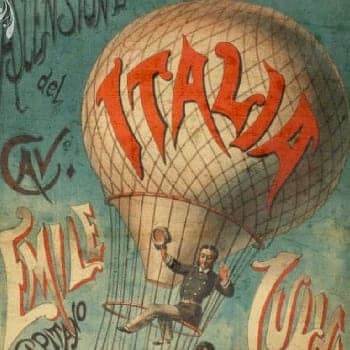
The trouble is, how do you commit them to memory?
And which are the most important to start feeling like you’re really using the language?
Or at least making headway?
Good news.
On this page, we’ll cover both. You’ll discover some of the most popular Italian phrases and learn how to commit them to memory.
The best part?
Italy historically has a deep connection to memory techniques you won’t want to miss.
Let’s dive in!
Which Basic Italian Phrases Should You Learn First?
When learning any language, it’s generally good to focus on everyday words and phrases. I’m talking about:
- Hello
- Goodbye
- Thank you
- How much is…
- Where is…
- Colors
- Days of the week/months of the year
- Numbers
One simple way to get up to speed is to analyze the most common words you use in your mother tongue. Ogden’s Basic English is a fantastic tool for doing that.
Then, using a browser based translator and a native speaker pronunciation site like Forvo, you can commit a solid 850-1000 word vocabulary to memory fairly quickly using the vocabulary memorization strategy.
When it comes to memorizing entire phrases, you basically want to chunk them down into 2-3 or 2-5 word units. Then, place these in a Memory Palace, something we’ll discuss further on. For now, let’s assume you’re doing your vocabulary work and get into my top recommended phrases as you learn basic Italian.
Let’s start with one that is very useful to have, especially at the beginning of your adventure with learning this wonderful language.
One: Non capisco.
This phrase means, “I don’t understand.”
An easy way to memorize it would be to assign a mnemonic image to a cap on your head made of a disco light (cap + disco = capisco).
You could even place this cap on the head of a nun to help you remember the meaning of “non” in this phrase.
Two: Mi scusi, non so parlare bene italiano
You may not want to admit that you don’t speak Italian well in the beginning. But knowing how to say, “Excuse me, I don’t speak Italian well” is a great way to help people understand that you need them to speak more clearly and slowly.
Okay, now enough with the necessities. Let’s turn now to a list of less common phrases that can help you pick up more of the language faster.
Three: Affetto e biscotti sono sempre ben accetti
“Affection and biscuits are always welcome.”
This phrase is used to create a sense of welcome or comfort. It is a lighthearted phrase that is good to have in your arsenal.
And it will teach you another common word you need to know: sempre for always. This is yet another reason that memorizing phrases is such a good thing to do: it help you develop your pattern recognition for the most common words in the language.
Four: In bocca al lupo!
This phrase might sound a little weird because it literally means, “in the mouth of the wolf.”
But it literally translates as “good luck.”
It’s a great alternative to “Buona fortuna” for good luck that will make you feel more connected to how Italians use the language more casually.
Five: Chi dorme non piglia pesci
This Italian idiom is their version of “the early bird catches the worm.”
Only in this version, the saying goes, “he who sleeps doesn’t catch any fish.”
One strategy when learning a phrase like this is to make mental connections. For example, when I look at “dorme” and realizes it means “he is sleeping,” I think of when I used to sleep in one of the dorms of my university campus.
This simple strategy helps you unlock a lot of the language much faster.
Six: Meglio un giorno da leone che cento da pecora
This phrase helps you learn how to construct comparisons. It means, “better one day as a lion than as 100 sheep.”
Basically, it’s the Italian way of saying quality is better than quantity.
Notice the “meglio,” which in this phrase means better. It instantly leaps out at me because T. S. Eliot famously used this comparison structure at the opening of The Waste Land where he says:
For Ezra Pound il miglior fabbro
Ultimately, Eliot is not just giving Pound a huge compliment. He’s also referring to a line in Dante’s Purgatorio:
“O brother, the one I point to with my finger,”
He spoke, and pointed to a soul in front,
“Was a better craftsman of the mother tongue.”
Although you might think this web of associations is not necessary to learn, Italians in fact are very proud of the history of their language. Dante was a huge part of its development, especially since he decided to write his most important poem in Italian instead of Latin.
That was definitely the “better” choice as far as I’m concerned. I’m a huge fan of practicing my Italian by reading Dante.
Seven: Non tutte le ciambelle riescono col buco
As a Canadian who used to eat a lot of Tim Horton’s, I can tell you that this phrase is true. They serve “Timbits” there, which are ostensibly the holes missing from donuts.
And that’s what this Italian phrase means, “not all donuts come with a hole.”
The literal meaning is “not everything goes as planned.”
Eight: Tra il dire e il fare c’è di mezzo il mare
This saying means that “there is a lot of sea between saying something and actually doing it.”
It makes this phrase another great way of learning some common features of Italian grammar. Having phrases like this in mind will definitely help you stop thinking that Italian is hard. In fact, it doesn’t take long to learn at all.
But as this saying goes, committing to learning Italian can be easier said than done. So let’s turn now to some tips on remembering and deeply absorbing the language with as much skill as possible.
5 Memory Tips to Remember Any Italian Phrase
The key to learning any language is what I call The Big Five of Language Learning.
This scientifically valid approach involves what researchers call interleaving these essential activities:
- Reading
- Writing
- Listening
- Speaking
- Memorizing
Let’s have a look at each in turn.
Reading Italian
A lot of people mistakenly believe that they can’t start reading Italian from their first day of studying the language.
Language learning expert Olly Richards has demonstrated that this simply isn’t the case. His StoryLearning books for Italian and other languages have helped millions of people start reading from day one.
Richards isn’t alone in this view. Reading straight away is a common theme that runs throughout the best books on language learning I’ve read. I’ve also found it true in my life as well. Reading is the key to making faster advancements in all the languages I’ve studied, especially when attempting to acquire more than one language at a time.
One reason reading is so important is that you have time to mentally work out what words mean. You also get a very high level of quality spaced repetition.
Writing Italian
People text these days more than ever and it’s a great way to practice your Italian.
There’s another reason writing is so important that relates to reading.
You have more time to think about how best to construct what you want to say. This is essential practice for the speaking and listening activities, and is as simple as using pen and paper.
Sure, there are language learning apps that can help. But I suggest you also spend time writing the old fashioned way for maximizing the value of your practice.
That’s true even if you use Chatgpt as part of your language learning process.
Listening to Italian
Never before has it been so easy to hear spoken Italian. Not only can you easily use the Internet to tune into many Italian radio stations. You can use Netflix to help you learn the language while listening and reading subtitles at the same time.
That said, it’s important to make sure you’re also listening to conversations held in the real world. Entertainment products are heavily dramatized and news involves a lot of formal language. Make sure you’re getting in conversations with native speakers as often as possible, ideally 2-3 times a week.
Speaking Italian
As with reading, many people delay the speaking process until they “feel” ready. Although not always, not speaking from day one is generally a mistake.
A process called acoustic encoding means that you’ll learn faster if you hear yourself speaking the language. The more often the better.
Using “mirroring” or “echoing,” you can learn even faster. Basically, this means listening to a recording, then recording yourself mimicking the native speaker.
As you continue to hear the native speaking and compare their pronunciation against yours, you will correct course quickly and enjoy much more accurate pronunciation much faster.
Memorizing Italian
I mentioned the Memory Palace for language learning above.
Although it’s not something for everyone, it’s a strong alternative for people who dislike rote learning using flashcards or Anki.
To use the Memory Palace technique, you create mental “copies” of real locations and use your imagination to place some of the associations I shared above in familiar spots.
For example, we discussed having a cap with a disco ball on the head of a nun for “non capisco” (I don’t understand). By placing associations like this along a mnemonic journey, it’s much easier to think back and reconstruct the associations.
In this way, you’ll quickly get a special form of spaced repetition that works for many of us very well. This particular memory technique is ancient, and as I mentioned, it has ties to Italian history.
For more, check out the body Memory Palace technique proposed by Giordano Bruno on this post about the ancient and medieval memory techniques that have helped so many.
And if you’d like more help, please sign up for my free memory improvement course now:
It will help you learn the Memory Palace technique and more tactics for learning Italian phases faster.
So, let me wish you luck in a much more authentic Italian way:
In bocca al lupo! You got this!







